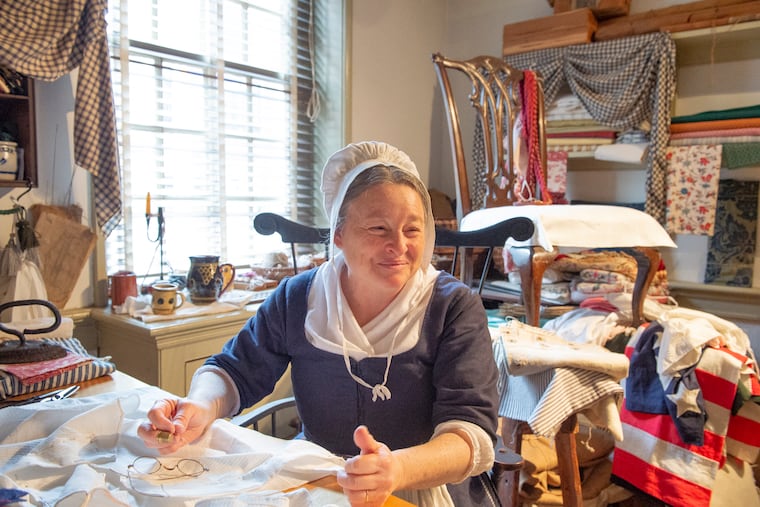Philly’s Betsy Rosses embrace modern entrepreneurism with an old-school upholstery biz
The Betsy Ross Betsys are getting into business.

If you attended middle school in the Philadelphia area, chances are you took a field trip to the Betsy Ross House. There was Betsy, in mannequin form behind sheets of glass, working on the flag she’s famous for.
Return to Ross’ Arch Street home these days, and you’ll find something different. For starters, Betsy is breathing. Her lifeless statue has been replaced by historic first-person interpreters, and they’re not just sewing flags anymore, either.
Since 2011, the house’s team of Betsys, headed by Carol Spacht, has been replicating the upholstery work that Ross once did within the same walls. They focused on in-house projects, completing curtains for the parlor and suite sets of bedding and curtains for two upstairs bedrooms. Now, with much of the house fully decorated, the team has begun taking on outside projects. They’re currently working on chair slip covers for the historic Woodford Mansion in Fairmount Park.
The house’s operations as the only known functioning 18th-century upholstery shop reflect the work the real Betsy did to support herself and her family. Ross is remembered for creating America’s famous pennant, but flag-making was little more than a side hustle for her. Day to day, she worked as an upholsteress, sewing chair covers, bedding, and window garments by hand. The upholstery work Ross had completed for George Washington was the reason he turned to her when he needed a flag.
“The flag was just one day,” house historian Kim Staub said. “But Betsy Ross is a vehicle for us to tell the story of 18th-century working women.”
» READ MORE: Which Philly tourist attractions are worth it? A newcomer and a native debate.
Partnerships like the one with Woodford Mansion bring mutual benefits. Projects that use historically accurate fabrics are often expensive. The fabric used to create the silk trim for one of the house’s bedding sets cost $3,000. A handwoven bed linen cost an additional $12,000. Historical sites like Woodford can apply for grants to finance the cloth purchases. In exchange, the Betsy team, composed of three interpreters depicting Betsy at different stages in her life, provides the labor and is enabled to practice their skills and take on new challenges. The house donated the labor for the Woodford project because it is the first time they’ve worked on furniture outside the house, but it will likely charge a fee for future ones.
Spacht has developed an expertise in upholstery and trains new Betsys, who typically have backgrounds in acting and performing, in the trade when they come on the job. Still, there is relatively little historical information to go on. Ross left few written records, and knowledge of centuries-old upholstery techniques is limited, so much of the team’s learning has come by doing.
“A lot of this stuff has never been done before in this authentic of a way, in a historical house,” Staub said. “We take it into a practical setting and try it and see what works. Sometimes we might not know why they use a certain stitch until we take it to a bed or to a chair and see, ‘OK, this is why they did it this way.’”
They’ve also sought the guidance of experts like Linda Eaton, the John L. and Marjorie P. McGraw director of collections and senior curator of textiles at Winterthur Museum.
“When people think of upholstery, they just think of guys nailing fabric to wooden frames for furniture,” Eaton said. “But in fact, in the late 18th century and early 19th century, when Betsy was in business, at least half, if not more, of an upholster’s business would be on the women’s side, making these textile furnishings and sewing.”
The team completes all of their upholstery work out in the open, in front of visitors. Spacht and the other Betsys explain what they are working on and offer guests the chance to ask questions and sometimes even to pitch in. A seam in one of the house’s bedding sets was sewn with the help of 40 different visitors.
“When we did the first project, we weren’t sure how the public would react, but we found that it was a really great way to start conversations,” Staub said. “It opens up a door for interaction.”
For Spacht, bringing history to life for others is the purpose behind her passion.
“The most meaningful moments are when someone suspends their disbelief, and all of a sudden, they have begun to talk to you like Betsy, and you realize they’ve entered your world,” Spacht said.
She recounted a particularly touching experience when a man returned to the house and pulled out a star she had cut and given to him during an earlier visit.
“He said, ‘You gave me this star five years ago. I’ve been to Afghanistan, and I’ve always kept that star that you gave me,’ ” Spacht said. “It brought us all to tears. You can touch people’s lives in ways that you can’t imagine. It’s all because you’re meeting people where they are and allowing them to talk to you, as opposed to just reading a panel about something.”